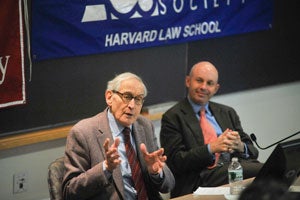The cases being decided this term by the Supreme Court may not be “super-duper” ones, said SCOTUS Blog co-founder Tom Goldstein, but they nonetheless yield significant insight into the direction of the Court.
Goldstein, who is also one of the nation’s leading Supreme Court litigants and teaches at HLS, joined Professor Charles Fried last week in discussing the Court’s current docket. At the event, which was co-sponsored by the progressive American Constitution Society (ACS) and the conservative Federalist Society, Goldstein foresaw the slow, but steady march of Court conservatives towards the erosion of affirmative action and campaign finance laws, while Fried worried that the Court is dangerously close to adopting an impractical and anachronistic approach towards criminal justice and public safety issues.
“I think those of you who are conservative members of the Federalist Society should be really pleased with the way the law is going, and those of you who are members of the ACS should be the opposite,” Goldstein said as an overview.
Still, he added, all sides benefit from an appreciation of the changing nature of law.
“It’s really good to understand, as you sit in law school, that the law is a dynamic, not a static thing,” he said.
Goldstein and Fried first discussed the abortion protest case McCullen v. Coakley. The issue is whether Massachusetts’ law prohibiting protest within 35 feet of a medical facility violates the First Amendment. A 2000 Court decision, Hill v. Colorado, upheld the enforceability of an 8-foot buffer zone. Goldstein said the Court could distinguish that case from Coakley, limit it, or even overrule it.
Goldstein said he thought the value set of the conservative justices made it likely they would generally lean towards protecting the free speech rights of protesters rather than preventing hassle or debate en route to a Constitutionally-protected abortion.
Fried said that the buffer zone rule established in Hill was an example of common sense decency that protects people on their way to a hospital, for an abortion or any other reason.
“It makes perfect sense,” he said. “If you’re going to the hospital, you don’t want to get hassled. Back off!”
One of the main factors hinting towards a more free speech over reproductive rights approach, the speakers said, is the replacement of Justice Sandra Day O’Connor by Justice Anthony Kennedy as the frequent swing vote of the Court. Fried cautioned Kennedy against doing something rash.
“If [Hill] gets overruled, then I would say Justice Kennedy has really lost it,” he said.
Fried had similarly sharp words about the likely outcome of the McCutcheon campaign finance law case. The case, in which Fried submitted a brief in support of existing law, is about the constitutionality of the aggregate limits on political donations. The plaintiff has asserted that the limits violate his free speech rights.
“It’s a terrible argument, but it may well prevail,” he said.
“I can probably only identify five people who would be persuaded,” Goldstein quipped.
Goldstein said he thought the prospects of the limits are not good—every campaign finance challenge under the Roberts Court has succeeded, and this is going to be another one, he said.
Affirmative action is also in “huge trouble,” Goldstein said.
In the Schuette case, the Justices are determining whether a state violates the Equal Protection Clause if it amends its Constitution to ban affirmative action. Goldstein said the argument that it does violate the clause has no chance and will likely be destroyed by the Court. Some saw a softening of the Court’s stance on admissions policies when the Court sent another affirmative action case, Fisher, back to the lower courts instead of rule directly on it. Goldstein said he believed that the Court only declined to rule on the case because if, in the same year that it overturned part of the Voting Rights Act, it crippled affirmative action “the optics of that suck.”
Finally, the speakers discussed a general trend of controversial public safety cases that has split the Court along unexpected ideological lines. Some of the specific cases included ones that allowed DNA swabs of criminal suspects, banned drug dog sniffing of a person’s residence without a warrant, and required search warrants before placing GPS trackers on cars. Those cases fell on both sides of the civil liberties versus public safety divide, reflecting the precarious nature of what Fried called an “unholy alliance.”
“You’ve got the people in 18th Century tri-cornered hats, [Justice Clarence] Thomas and [Justice Antonin] Scalia, joining up with [Justice Ruth Bader] Ginsburg, [Justice Sonia] Sotomayor, who think that nobody should ever be convicted of anything.”
When those four justices are able to win over Kennedy to their side, “things that would make sense in any other rational country are made unconstitutional,” Fried said.
Fried said the debate could be characterized as “Thomas Jefferson and John Adams and Nino Scalia meet the 21st Century. And as far as Nino Scalia is concerned, the 21st Century loses. Now, fortunately, you have a lot of wide variety of justices who have their heads screwed on right.”
Goldstein said the debate was ultimately one between idealism and pragmatism, and that its future may well rest in how former HLS Dean and current Justice Elena Kagan decides to approach the conflict.
“It’s very interesting what’s going on and it will show up when finally the NSA surveillance stuff gets to the Supreme Court,” Fried said.
